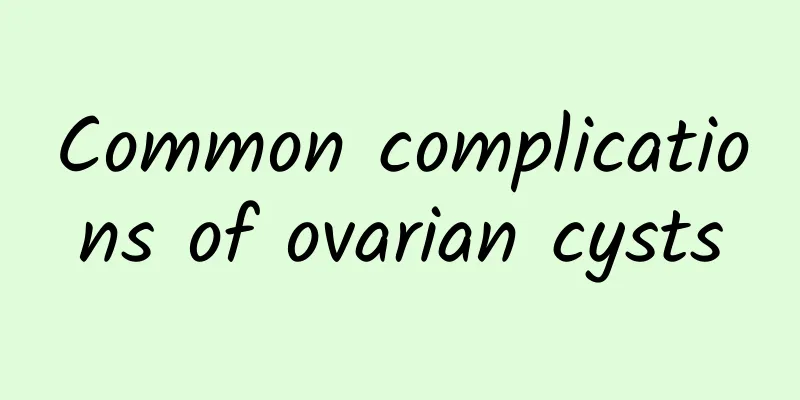Common complications of ovarian cysts

|
Ovarian cysts are a serious disease that endangers women's health. If not treated in time, complications of ovarian cysts will occur, further harming female friends. What are the common complications of ovarian cysts ? Let's talk about the common complications of ovarian cysts. Common complications of ovarian cysts include: 1. Ovarian tumor It is the most common complication of ovarian cysts. Although the ovaries are small in size, they are the organs where tumors are most likely to occur; the number of tumor types is also the highest among all organs in the body. Ovarian cysts are common gynecological diseases. They can occur at any age, but are more common in women of childbearing age. Since the ovaries are located in the pelvic cavity, they cannot be directly observed, and there are no symptoms in the early stages. There is a lack of good early diagnosis and differentiation methods. Once a malignant tumor is discovered, it is often an advanced lesion. Therefore, to date, the 5-year survival rate of ovarian cancer is still only 25%-30%, making it the most threatening disease among gynecological tumors. 2. Tumor pedicle torsion About 10% of ovarian cysts are torsion. The conditions for ovarian tumor pedicle torsion are that the pedicle is long and the tumor is as big as a fist or a fetal head, there is no adhesion to the surrounding tissue, and the tumor is easy to move in the abdominal cavity. It is also a common complication of ovarian cysts. Cystic teratomas, mucinous and serous cystadenomas are most likely to have pedicle torsion. The pedicles of these tumors are generally long and the center of gravity is biased to one side. The tumor is easily rotated by intestinal peristalsis or changes in body position. 3. Rupture This type of complication of ovarian cyst refers to the cyst rupture or squeeze, and its contents overflow into the abdominal cavity; the latter refers to the cyst contents eroding the cyst wall and entering the abdominal cavity, such as the papillary protrusions of serous cystadenomas or cancers penetrating the tumor wall. The rupture rate of ovarian tumors is about 3%, and malignant teratomas are most likely to rupture. Spontaneous rupture is more common. Due to rapid growth, the local blood supply of the cyst wall is insufficient, and the incremental cystic fluid breaks out from the weak part of the cyst wall and overflows into the abdominal cavity. Different tumor contents can cause different consequences in the abdominal cavity, and in the process of forming these conditions, it can cause membranous inflammation, intestinal adhesions, and even intestinal obstruction. This is also one of the common complications of ovarian cysts. |
<<: Warning: Several common hazards of ovarian cysts
>>: Long-term sitting requires vigilance against the cause of adnexitis
Recommend
It is important for women to take measures to prevent cervical erosion
Cervical erosion is a disease suffered by most pe...
What is the cause of endometrial thickness after years of amenorrhea?
Thick endometrium after years of amenorrhea may b...
How is ovulation bleeding diagnosed?
How can ovulation bleeding be diagnosed? Many peo...
Drink to stay slim! Tips on eating porridge and soup without gaining weight
During the Chinese New Year, meat and fish are in...
Is it possible to slim down your belly without losing your breasts? 5 major weight loss questions, experts honestly say...
Want to lose weight but not to the chest? Can you...
Why are there always a lot of blood clots during menstruation?
Why are there always a lot of blood clots during ...
Typical symptoms of adnexitis
Adnexitis is a common gynecological disease in li...
Is “additive-free” food more dangerous? ! There are tips to avoid buying or eating the wrong food
People who value food safety will pay attention t...
What medicine should I take for pelvic effusion and low back pain?
Physiological effusion will not exceed 1cm, and i...
Does the thickness of the endometrium affect pregnancy?
Will the thickening of the endometrium affect pre...
What is mild cervical erosion? Pay attention to 3 nursing measures for cervical erosion
Mild cervical erosion is a normal physiological s...
What are the symptoms of pelvic peritonitis?
Pelvic peritonitis is one of the most common infl...
How to prevent ovarian cysts
How to prevent ovarian cysts? Ovarian cysts are a...
To reverse diabetes, you must eat these 5 foods to stabilize blood sugar! Research confirms: Beans and pumpkin can regulate blood sugar
For those who often eat out for three meals a day...
Can pelvic inflammatory disease be treated?
Can pelvic inflammatory disease be treated? Chron...









